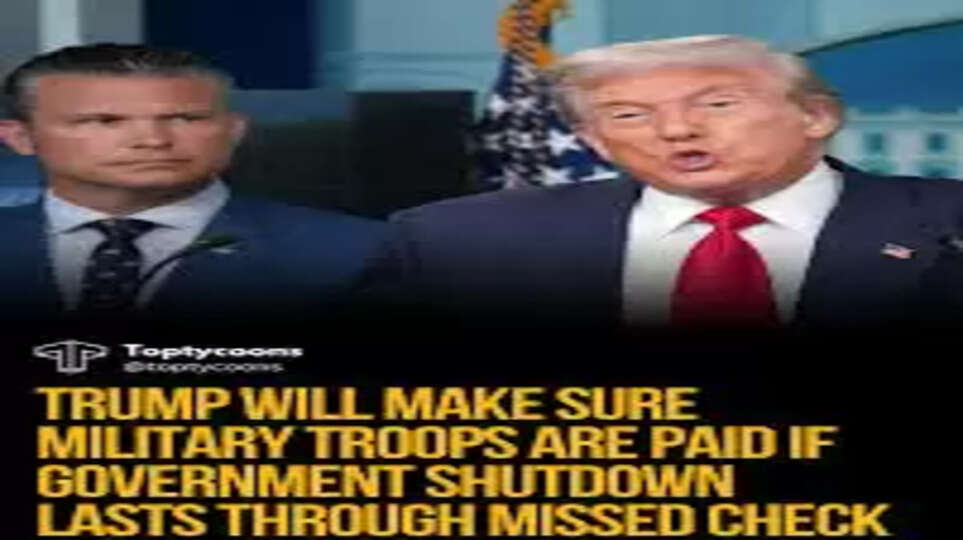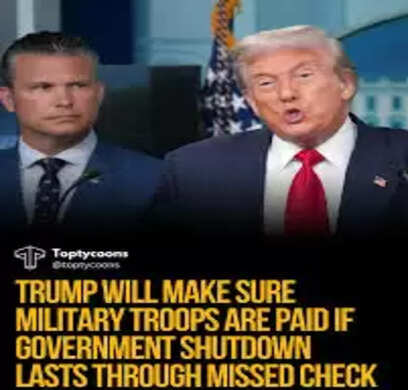Presidential Directive: Paying the Troops Amidst the Shutdown
President Donald Trump has used his authority as Commander-in-Chief to order the Department of Defense to pay active-duty military personnel on the October 15th payday, circumventing the government shutdown. Discover the funding mechanism, the legal debate, and why this order does not apply to all federal workers.


Introduction
As the government shutdown drags into its third week, threatening the first payday for many federal employees, a critical intervention has been made for over a million active-duty military personnel. President Donald Trump has invoked his authority as Commander-in-Chief to ensure that U.S. troops will receive their paychecks on October 15, 2025, despite Congress’s failure to pass new appropriations. This executive directive, while a relief to military families, highlights the constitutional tension between the Executive and Legislative branches regarding the power of the purse, and it does not extend the same relief to hundreds of thousands of furloughed civilian federal workers, including the majority of IRS staff.
Bypassing Congress: The Funding Mechanism
The ability of the Executive branch to pay the military during a lapse in appropriations stems from a creative use of existing, multi-year funding sources within the Department of Defense (DoD).
Use of "Available Funds"
In a public statement, President Trump directed the Secretary of War to utilize "all available funds" to get the troops paid. The mechanism involves identifying and repurposing unobligated, multi-year funds that are already appropriated but were originally designated for other purposes, such as research, development, testing, and evaluation (RDT&E) from the previous fiscal year.
The Pentagon's Office of Management and Budget confirmed that approximately $8 billion of these unobligated RDT&E funds were identified. These funds remain available for two years and can be repurposed, at the President's discretion, to cover the immediate payroll needs of the active-duty military. This move effectively bypasses the congressional deadlock on a new spending bill.
A Short-Term, Department of Defense Solution
Crucially, this is a temporary, short-term fix that only addresses the military’s mid-month paycheck. The continuation of pay for the rest of the shutdown period would require the identification of additional funds or, more likely, an end to the government funding lapse. Furthermore, this mechanism only covers personnel under the Department of Defense (DoD).
The Constitutional and Political Fallout
The President’s directive has provided immediate political relief from one of the most significant pressure points of the shutdown—missing military paychecks—but it has also intensified the political and constitutional debate.
The Power of the Purse
The U.S. Constitution grants Congress the "power of the purse," meaning only Congress can authorize the expenditure of federal funds. While the President has broad emergency authority as Commander-in-Chief, the act of unilaterally redirecting previously appropriated funds to cover salaries is a point of contention. Critics argue that this action sets a controversial precedent of the Executive branch overriding congressional spending mandates, potentially opening the administration to legal challenges.
The Coast Guard Exception
One of the most immediate and painful shortfalls of the DoD-specific funding workaround involves the U.S. Coast Guard. While a military branch, the Coast Guard falls under the Department of Homeland Security (DHS) during peacetime, an agency that is heavily impacted by the shutdown. Since the President's order was directed to the Department of Defense, it did not initially cover Coast Guard personnel, who were facing a missed paycheck. Following the initial order, the DHS Secretary announced similar measures to ensure Coast Guard members would also be paid, utilizing funds from the same law the President invoked.
A Stark Contrast for Furloughed Civilians
The Presidential order to pay the military creates a stark contrast for the hundreds of thousands of other furloughed federal workers, including the majority of the IRS staff handling tax processing and taxpayer services, who will miss their paychecks.
Unlike the military, these civilian employees must wait for Congress to pass a funding bill and for the mandatory back pay legislation (required by law since the 2019 Government Employee Fair Treatment Act) to take effect. While they are guaranteed to receive their back pay after the shutdown ends, the immediate financial hardship remains. This differentiation emphasizes the political prioritization of military pay during the ongoing budget impasse.
Conclusion
President Trump’s order to pay active-duty troops on October 15th, utilizing repurposed Department of Defense funds, serves as a significant, albeit temporary, buffer against the financial impact of the government shutdown on service members. This move, executed under the authority of the Commander-in-Chief, has successfully removed one of the major political catalysts that might have forced an early end to the funding lapse. However, the workaround underscores the deep political stalemate and the fact that the majority of civilian federal employees, including a large portion of the IRS workforce, must continue to work without pay or remain furloughed until Congress acts.
FAQ's
Q1: How is the President paying the U.S. troops during the government shutdown?
A1: The President is using his authority as Commander-in-Chief to order the Department of Defense (DoD) to repurpose unobligated, multi-year funds (specifically about $8 billion from RDT&E accounts) that were already appropriated by Congress but designated for other programs. These funds are being temporarily redirected to cover the military's payroll on October 15th.
Q2: Does this order cover the U.S. Coast Guard?
A2: Initially, no. The Coast Guard falls under the Department of Homeland Security (DHS), which is separate from the DoD. However, the DHS Secretary subsequently announced that a similar funding workaround would be implemented to ensure Coast Guard personnel also receive their paychecks.
Q3: Will other federal employees, like those at the IRS, be paid under this order?
A3: No. This directive is specific to military service members under the DoD. Furloughed and working-without-pay civilian federal employees, including IRS staff, will not receive their paychecks until the government shutdown ends and Congress passes a measure to provide back pay, as required by law.
Q4: Is the use of repurposed funds to pay the military legal?
A4: The practice is often considered a legal gray area and may be subject to legal challenge because the U.S. Constitution grants Congress the "power of the purse." However, the Executive branch asserts that the President’s authority as Commander-in-Chief, combined with the availability of multi-year funds, justifies the temporary reallocation to protect national security.
Q5: Is this a long-term solution to military pay during the shutdown?
A5: No. The funds identified are only sufficient to cover the October 15th payroll. A prolonged shutdown would require Congress to pass a new appropriations bill or a standalone military pay bill, or the Executive branch to identify additional, legally available funds.
